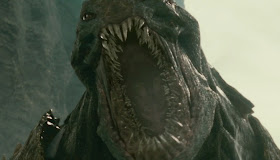At the risk of stating the obvious, this film is not for everybody. Only those with a certain interest in visual effects need apply, and if you're one of those folks who thinks CGI is the best thing ever, don't bother watching at all. Or wait a minute, maybe you should watch it! Maybe this film is exactly what you need?
What Sense of Scale does is paint a picture of how the model makers worked, and what kind of people they are. The film opens with a few of the interviewees explaining how they got started in the business, then we move on to stories from Star Trek: The Motion Picture (1979) and Space: 1999 (1975). Those who have followed the model makers through their most exhilarating period - the late 70's to the late 80's - will see many familiar faces.
The film moves from interview to interview at a decent pace. There's a good flow of information, and these people have so many fantastic stories to share. Plenty of well-known movies are covered, from Star Wars (1977) and Alien (1979) to recent projects like Moon (2009), The Aviator (2004), and Shutter Island (2010) - and I have to highlight The Abyss (1989) as one of my personal favorites.
The film covers a couple of central subjects with headlines like "High and low budget productions" or "CGI and Practical effects". Surprisingly most of the model makers enjoy the low budget productions more than the big budget films, and their explanations for this are wonderful. When the discussion turns to CGI there's a certain amount of bitterness to detect among some of the model makers, and rightfully so. It must leave a bitter taste to be pushed aside in favor of shiny CGI, only to watch this new toy produce so many inferior results (especially in the early days). I guess the film occasionally gets a little inside baseball, but since we've already established that you need to have a certain interest in the field to begin with that's not surprising.
In terms of the filmic style Sense of Scale is not rocket science. Each interview is only shot from one angle, with one framing, but the footage looks reasonably good and the sound is very clean - only a bit of mike noise here and there.
Hundreds of behind the scenes stills are used to break up the interviews or illustrate what the model makers are talking about, and perhaps that sounds a little dull, but I must underline that these are AMAZING stills, and I could easily watch a slide show just with them. A simple moody score occasionally plays in the background, when there's a title card or a headline for a new section, and that's it. It's very simple, but it works. We're here for the stories, after all, not flashy filmmaking.
One thing I was missing, though, was some film clips to illustrate the stories, but for an independently produced film like this it was probably impossible to secure rights to actual film clips, and that's a shame. It's also a shame that more behind the scenes footage was not included - all we get is a handful of brief clips - but again, this was probably impossible to get.
Another thing I could have used was film titles on the behind the scenes stills. Mostly this is not a problem, but every now and then there was a model or a landscape I couldn't identify, but it didn't affect the overall appreciation of the film.
THE DVD
No bells and whistles on this one.
Disc 1 contains the main feature, with a running time of 136 minutes. There's a "play feature" button, and that's it. No subtitle options, no alternate soundtracks, no chapter overview, no extras, nothing. Take it or leave it. Disc 2 features 45 minutes of deleted scene. There's also only a "play deleted scenes"-button and that's it.
The footage is presented in 16:9 with stereo sound.
FINAL THOUGHTS
I feel like I should underline the low-budget nature of this film. This is not a big polished behind the scenes documentary, but there are still several reasons for buying and watching it.
First of all, it's a treat to watch these talented artists talk about their work. Second, making models for movies is a disappearing art form. That's a real shame, and we need to remember all the wonderful images models have given us throughout film history. This film will help us with that.
And finally, you should buy and watch this film, because a guy like Berton Pierce took the time to make it. Sense of Scale is a work of passion, and there's simply nothing else like it out there.
NOTE: The film can be bought from this official website.
























